Galapagos Spirit
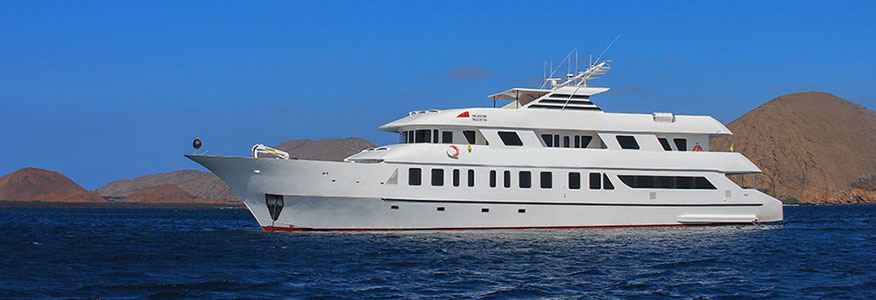


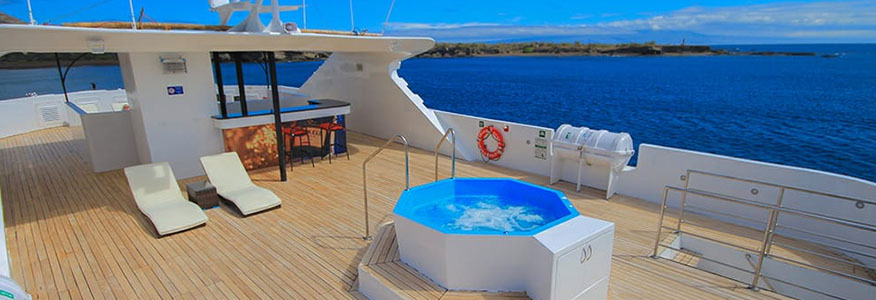

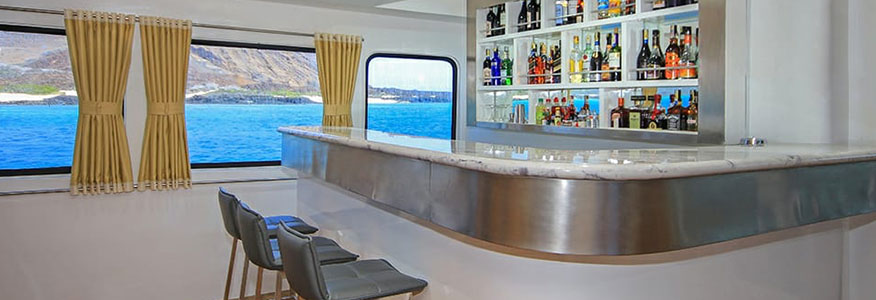
Galapagos Spirit
Named after the spirit of a nature lover that the Galapagos islands awake in each visitor that lives a Darwinian experience and admires this unique wildlife in the world, GALAPAGOS SPIRIT combines luxury and comfort while exploring this human heritage site. With capacity for 16 passengers, SPIRIT has four suites in the upper deck and five stateroom cabins in the main deck.
The Galapagos Spirit Luxury Yacht, is a 16-passenger galapagos motor yacht built in 2018 with the newest technology. It offers nine air-conditioned cabins all boast ocean views to enjoy of the wonderful landscape and private bathrooms to rest with privacy and confort. There are four spacious luxury cabins and private balconies. Travelers can enjoy jacuzzi, dining room and bar at any time of the trip.
Day 1 - Sunday: Baltra / Punta Carrion
This morning you will be transferred to the airport for your flight to the Galapagos Islands. Please note the pick-up time will usually be as early as 4am as the airport is a one hour drive and you must allow for delays and check-in times. (Your tour leader will confirm this time with you at the pre-departure meeting on Day 1. A US$20 per person transit card is payable on departure at Quito Airport and a US$100 per person national park entry fee is payable on arrival on the islands. Please have cash on hand for these transactions as using credit cards can be time consuming.
You will be met in the arrival hall of the airport by a National Park Guide, and transferred to Spirit Galapagos Yacht. Lunch will be served on the boat. Your first stop in the afternoon will be Punta Carrion, located in north-eastern Santa Cruz. This is a shallow and protected cove, ideal for your first snorkel and swim in the Galapagos! Wildlife is plentiful; keep your eyes peeled for blue-footed boobies, Galapagos herons, great blue herons and underwater swim among rays and white-tipped reef sharks.
Day 2 - Monday: Isabella Island
Today you will wake up on the South Coast of Isla Isabela, the largest of the Galapagos Archipelago. Isabela was formed by five giant volcanic craters, all of which are still considered active. The island is located in one of the youngest geological areas in the world, having been formed less than 1 million years ago.
This southern coast of turquoise blue waters has the largest area of beaches in the Galapagos. You will visit Las Tintoreras, where from the viewing walkway you can look down into this narrow channel to see a colony of white-tipped reef sharks swimming and sleeping, and the occasional playful sea lion among them! Blue-footed boobies and penguins, marine iguanas and crabs also make their home here, and the waters provide further opportunities to swim with turtles. Here you will also visit the Giant Tortoise breeding center and the Wall of Tears, constructed from lava by prisoners of the penal colony here between 1946 and 1959 as punishment. Please note there's a US$5 fee to be paid upon entering Isla Isabela.
Day 3 - Tuesday: Floreana Island
The island of Floreana is a highlight of any Galapagos cruise, rich in natural wonders and wildlife. You will go ashore at Punta Cormorant where the sand is made up of fine olivine crystals, a glassy volcanic mineral, giving the beach an olive-green color. It is the best place to see Galapagos sea lions.
Today is also one of your finest opportunities to see pink flamingos and other water birds wading in the lagoons, including pintails and stilts. Just offshore, the Devil’s Crown is an old eroded volcanic cone and a popular roosting site for seabirds such as boobies, pelicans and frigates. Red-billed tropicbirds can also be seen nesting in the rocky crevices.
The center of the cone is an outstanding snorkeling spot, perhaps the most remarkable in the entire archipelago, full of sea lions and colorful fish. Floreana is also home to Post Office Bay, where 18th century whalers used a barrel as an unofficial mail drop. This custom continues to this day with visitors to the Galapagos – post one of your own, or see if there are any you could deliver back home!
Day 4 - Wednesday: Santa Cruz Island - Highlands / Charles Darwin Station
Today you will visit Santa Cruz, the second largest island in the Galapagos. Afterward you'll head up into the highlands for a total change of scenery. Beginning at the coast you will travel across Santa Cruz through the agricultural region and into the misty forests. This is a lush humid zone containing miconia bushes, scalesia and inactive volcanic cones. Santa Cruz has more endemic plants than any of the other islands and you are likely to see Galapagos giant tortoises in their natural habitat and perhaps even the bright red feathers of a vermillion flycatcher!
The small town of Puerto Ayora is the economic center of the archipelago, and home to the Charles Darwin Research Station. As well as undertaking vital conservation work, the station also makes for interesting exploration and offers the best opportunities for close encounters with giant tortoises, you will also observe baby tortoises and land iguanas.
Day 5 - Thursday: Santa Fe Island / South Plazas
Santa Fe is home to more sea lions, and these ones are very eager for swimming partners! It’s a lovely place to take a dip, and the landscape on the inland trails is also beautiful, with cacti forests home to a unique sub-species of land iguanas. Hiking towards the cliffs on Santa Fe will lead you to a forest of prickly pear cactus.
A member of the cactus family, their name comes from the pear shaped fruit the plant produces. Santa Fe is home to endemic land iguanas. Once back at the beach you will have free time to snorkel back in the lagoon. Playful sea lions pups and florescent fish make for fascinating company. A small island, Plaza Sur is nonetheless a place of great beauty, where you will get close to sea lions and onto trails past one of the Galapagos’ largest land iguana populations, resting amid cacti and volcanic landscapes colored bright red and green by sesuvium. The island’s rugged southern cliffs are an excellent place to spot tropicbirds and swallow-tailed gulls, as well as ‘the gentlemen’s club’, a gathering of male sea lions either too young or too old to be beach masters!
Day 6 - Friday: Española Island
Today you will cruise to the island of Española - the southernmost island of the Galapagos and one of the most spectacular. Because of its remote location, this island has a large population of endemic fauna. It is the breeding site for nearly all of the world's 12,000 pairs of waved albatrosses and also home to colonies of blue-footed and masked boobies. Trails from the golden beaches, where sea lions bathe and marine iguanas make their way towards the water, will lead you right through the middle of booby colonies, and Galapagos doves and mockingbirds are also often seen. You will also visit the beautiful white sandy beaches at Bahia Gardner, which are great places for swimming and relaxing. The rocks off the coast provide excellent snorkeling opportunities, with reef sharks, turtles and many species of tropical fish, including surgeon and angelfish, often seen. The small white-tipped reef sharks are also often spotted resting under the rocks.
You will also pay a visit to Punta Suarez, one of the most attractive locations in the Galapagos and home to large and varied wildlife population - a walk along its trails will take you to a cliff top viewpoint, where you'll gain a magical panorama. Boobies line the rocky shoreline beneath you, while frigate birds may be seen overhead; nearby enormous male sea lions can be seen lounging and albatross use the cliffs as their ‘runway’, helping become airborne by the southeast winds that blow across this part of the island. If you’re lucky you’ll see the elaborate courtship rituals performed by albatrosses before the female chooses her lifelong mate!
Day 7 - Saturday: Pitt Point and Kicker Rock / Lobos Islands
This morning you will visit Punta Pitt on the eastern end of Isla San Cristobal. Walk to the top of the volcanic hill for expansive views of the sparsely vegetated area. A variety of seabirds nest here, including blue-footed boobies and frigates. Close by you will pass through Leon Dormido (Kicker Rock), which is a magnificent rock in the middle of the sea, the shape resembles a sleeping lion. The rock rises 150 meters above the surface and is divided into two parts by a narrow channel. You will also visit Isla Lobos, a tiny island almost touching Isla San Cristobal. This is the perfect time to witness the always friendly sea lions as they play in the calm shallow waters here.
Day 8 - Sunday: San Cristobal
As flights to the mainland from Galapagos depart mid-morning, it is an early start for our last morning on the islands. Depending on the time of our flight, our time spent on this final excursion could be limited.
Visit the Interpretation Centre in the morning. The center brings the history and geography of the archipelago to life, from its volcanic origins to the present day. The human history exhibit offers an insight into the discovery and colonization of the Galapagos, and the reality of the problems the islands face today is also explored.
This is a great way to complete your time in the Galapagos. This will be your final excursion before you head to the airport in San Cristobal for your flight back to Quito. As you will be leaving the boat this morning, please remember that if you have enjoyed the services provided by your guide and crew, a tip would be very much appreciated by them.
As a guideline we recommend each passenger consider US$15 per day for the crew and US$10 per day for your guide. You can leave tips in envelopes that are placed in your cabin on this last day of your journey.
Day 1 - Sunday: San Cristobal / Interpretation Center
A US$20 per person transit card is payable on departure at Quito Airport and a US$100 per person national park entry fee is payable on arrival on the islands. Please have cash on hand for these transactions as using credit cards can be time consuming. You will be met in the arrival hall of the airport by the National Park Guide, and transferred to your Spirit Yacht.
This afternoon you will travel into the interior of the island to visit the highlands site of ‘Galapaguera of Cerro Colorado’ (Red Hill) where the national park has established a breeding program and information center for tortoises. Here, we will be able to see giant tortoises in their natural habitat and learn all about their origin, evolution and their threatened future.
Day 2 - Monday: Bartolome Island / Sullivan Bay
Bartolomé is a relatively new island in the archipelago and traces of its volcanic past can be seen everywhere, as evidenced by the amazing lunar-like landscape.
The Pinnacle Rock is one of the most photographed sites in the Galapagos – an abrupt jag of rock protruding from the earth like a tooth, while nearby two golden bays back onto each other.
You can hike to the top of a once-active volcano here, and enjoy superb views across to Sullivan Bay, on nearby Santiago Island.
Day 3 - Tuesday: Espumilla Beach / Egas Port
Today you will visit some wonderful places. Espumilla Beach, on the northern coast of Santiago Island in James Bay, is one of the most idyllic locations in the Galapagos Islands and is an important nesting site for marine turtles. Espumilla beach is also well known for its Palo Santo Forest and some extraordinary lava formations.
This morning you will also visit Caleta Bucanero (Buccaneer Cove), a natural monument of rocks caused by sea erosion. This cove was used by pirates to careen their ships. It is a place of local legends and stories! Port Egas is a black sand beach located on the west side of James Bay and northwest of Santiago Island.
South of the beach is Sugarloaf Volcano, which has deposits of volcanic tuff. This site is named Puerto Egas, after Hector Egas who last attempted to mine salt here. The walk along the beach offers hundreds of marine iguanas, California sea lions and Galapagos fur sea lions.
Day 4 - Wednesday: Santa Cruz Island - Highlands / Charles Darwin Station
Today you will visit Santa Cruz, the second largest island in the Galapagos. Afterward you'll head up into the highlands for a total change of scenery. Beginning at the coast you will travel across Santa Cruz through the agricultural region and into the misty forests. This is a lush humid zone containing miconia bushes, scalesia and inactive volcanic cones. Santa Cruz has more endemic plants than any of the other islands and you are likely to see Galapagos giant tortoises in their natural habitat and perhaps even the bright red feathers of a vermillion flycatcher!
The small town of Puerto Ayora is the economic center of the archipelago, and home to the Charles Darwin Research Station. As well as undertaking vital conservation work, the station also makes for interesting exploration and offers the best opportunities for close encounters with giant tortoises, you will also observe baby tortoises and land iguanas.
Day 5 - Thursday: North Seymour / Mosquera Islet
Today you will take a morning excursion to North Seymour. The trail on North Seymour crosses the inland through the island and then explores the rocky coast. Along the way the trail passes colonies of blue footed boobies and frigate birds. The magnificent frigate bird, a large black bird with a long wingspan, and a hooked beak, is extremely fast and has excellent vision. Frigate birds are known for the large red pouch on their necks. During mating season the males throw back their heads, inflate the pouch (sometimes to the size of a soccer ball), and shake trying to capture the attention of female frigates.
Boobies and frigates have an interesting relationship. Sharing the same nesting area on North Seymour, blue-footed boobies nest on the ground making their nests from the twigs of the palo santos trees, while the frigate birds nest just above them in the saltbushes.
After lunch you will visit the small sandy island of Mosquera, it’s a relaxing, picturesque stop. Along the rocks and in the tide pool, sally lightfoot crabs (red lava crabs) scamper back and forth, skipping across small pools of water in search of food. These crabs with their bright red shell tops and blue under shells are stunning against the black lava.
Day 6 - Friday: Black Turtle Cove / Dragon Hill
Today you will take a morning excursion to Caleta Tortuga Negra (Black Turtle Cove) - a red mangrove wetland on the north shore of Santa Cruz Island. You will paddle among the cove’s peaceful waters, for your first taste of the underwater riches of this region – it’s a wonderful place to see green turtle and is a nursery for rays and Galapagos sharks.
There is also abundant birdlife, such as the yellow warbler and lava heron. This is also a breeding area for turtles, so it is not uncommon to see them mating. Go for a walk on Cerro Dragón (Dragon Hill) this afternoon, this is one of the best places to see land iguanas in the islands. You’ll walk along the trail from the beach, and along with the land iguanas, other sightings include marine iguanas, flamingos and Sally Lightfoot crabs.
Day 7 - Saturday: Chinese Hat / Rabida Island
Rabida, also known as ‘Jervis’ is a tiny island sitting roughly five kilometers south of Santiago and is one of the most striking of the archipelago. Introduced species were eradicated in 1971, meaning that the indigenous wildlife has now been returned to a state of splendid isolation. Additionally, volcanic activity here has produced vivid, fantastical colors, not least the beaches of red sand and cliffs of scarlet.
From the shore, the trail leads through to what is one of the finest lagoons in the Galapagos for viewing flamingos. Rabida is also a wonderful place to spot nesting pelicans. Elsewhere, pintail ducks, marine iguanas and sea lions are all present. Sombrero Chino is a small islet located near the south-east coast of Santiago. It's shaped like a Chinese hat (Sombrero Chino) when seen from afar, and is geologically fascinating, with many lava tubes leading from the cone to the coast.
Day 8 - Sunday: Bacjas Beach / Baltra
As flights to the mainland from Galapagos depart mid-morning, it is an early start for our last morning on the islands. Depending on the time of our flight, our time spent on this final excursion could be limited. Today you will take an early morning excursion to Las Bachas, which was so named after the barges abandoned by the American Navy here in the 1940s. The sandy, white beaches of Las Bachas on the north shore of Santa Cruz Island are a nesting site for the Pacific green turtle, and marine iguanas are also commonly seen. The sand here is particularly white and soft as it is made of decomposed coral.
The rocks provide great snorkeling and are the perfect habitat for the Sally Lightfoot crabs, which are plentiful on the island. A saltwater lagoon near to the beach is home to flamingo and whimbrel, and look out too for great blue herons. This is your final excursion before you return to the airport in Baltra for your flight back to Quito.
As you will be leaving the boat this morning, please remember that if you have enjoyed the services provided by your guide and crew, a tip would be very much appreciated by them. As a guideline we recommend each passenger consider US$15 per day for the crew and US$10 per day for your guide. You can leave tips in envelopes that are placed in your cabin on this last day of your journey.
GROSS RATES |
8D/7N | 7D/6N | 5D/4N |
|---|---|---|---|
| Charter | $98.800 |
- |
$61.750 |
| Rates per person Standard Cabin |
$5.972 |
- |
- |
| Rates per person Balcony Suite |
$7.875 |
- |
- |
Main Deck
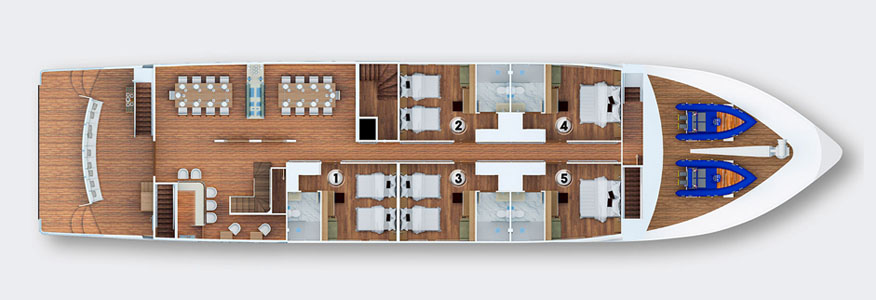
Upper Deck
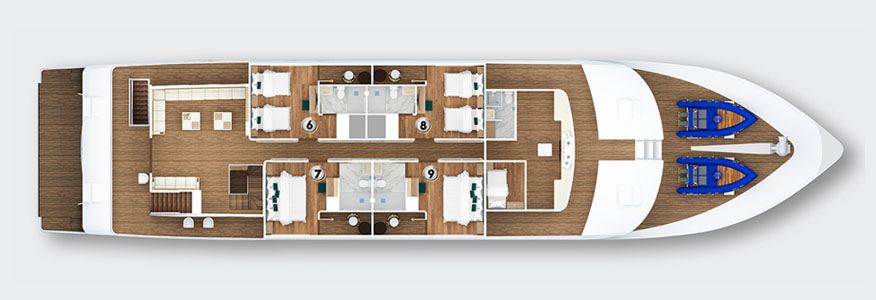
Sun Deck

Specifications
| CLASIFICATIONS: |
|
| CABINS: |
|
| CREW: |
|
| SPECIAL AMENITIES: |
|
| CAPACITY: |
|
| CABIN SIZES: |
|
| BATH SIZE: |
|
| BALCONY SIZE: |
|
| HULL TYPE: |
|
| LENGTH: |
|
| SPEED: |
|
| BED SIZES: |
|
| VOLTAGE AND PLUGS: |
|
| YEAR BUILT: |
|
| NEXT MAINTENANCE: |
|


